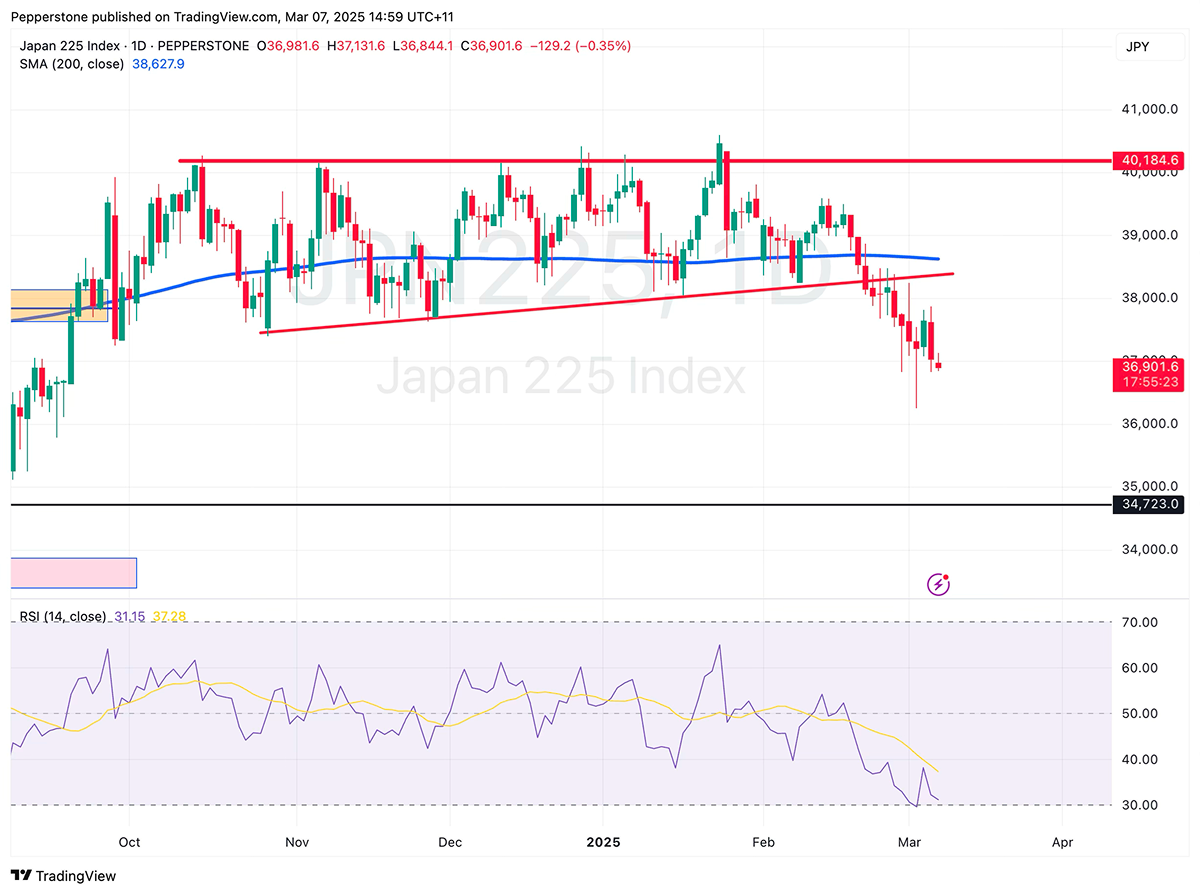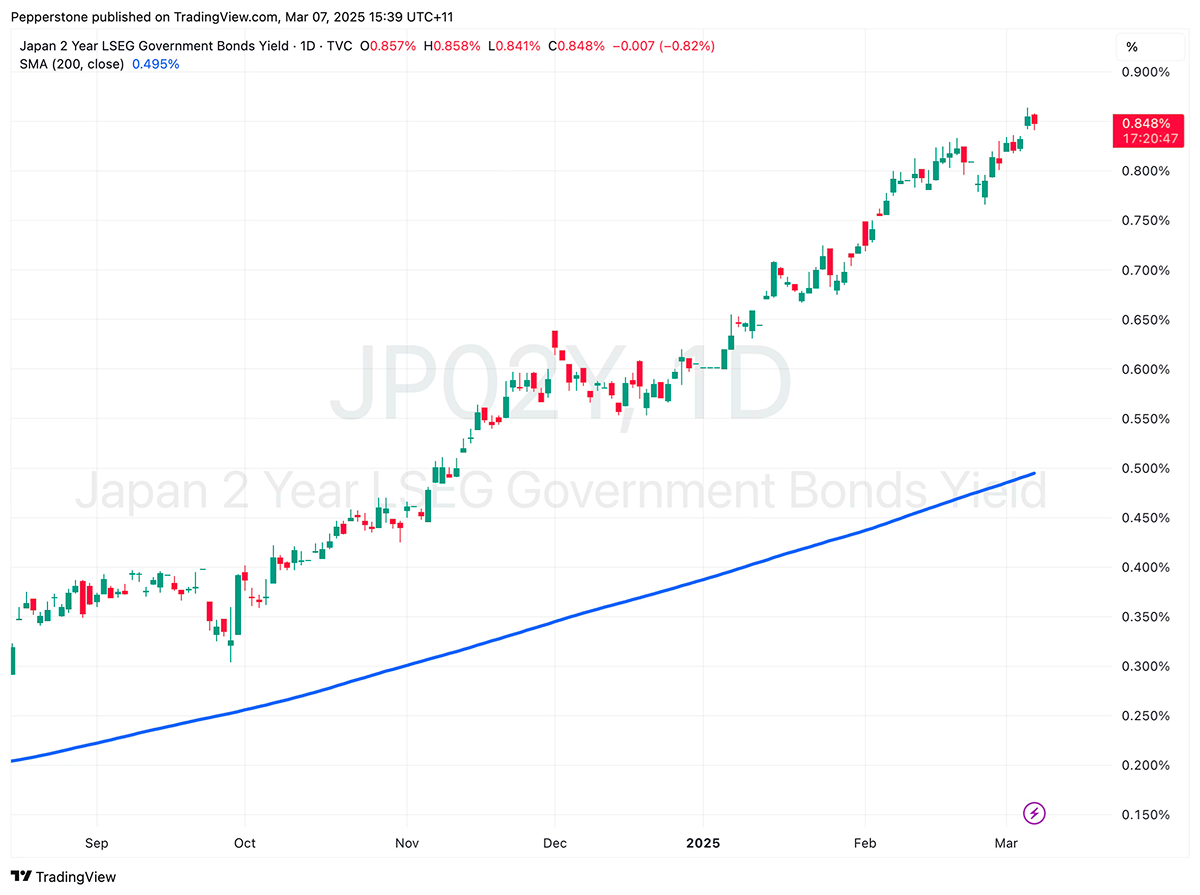- English
- 简体中文
- 繁体中文
- ไทย
- Tiếng Việt
- Español
- Português
- لغة عربية
Nikkei 225: Pressure and Breakthrough Under the Shadow of Tariffs
.jpg)
The Dual Faces of the Nikkei Index: Domestic Economy and Global Ties
The Nikkei 225 Index is one of the most representative barometers of the Japanese stock market, composed of 225 leading companies listed on the Tokyo Stock Exchange. This index is price-weighted, with factors such as market capitalization, trading volume, and liquidity playing a key role in determining the constituent stocks.
The constituent stocks undergo adjustments every October, aiming to provide a comprehensive reflection of Japan's economic development. In recent years, with the rapid growth of the technology sector, the proportion of technology and advanced manufacturing industries in the index has significantly increased.
Given Japan's expanding overseas investments over the past 30 years, approximately 60%-70% of the revenue for Japanese listed companies comes from abroad, particularly from the U.S. and Asian markets. As a result, despite being composed of Japanese companies, the Nikkei Index not only mirrors the trends of the domestic economy but also indirectly reflects changes in the global economic landscape, making it an important window for international investors to observe Japan's economy.
Market Pains Amidst a Multitude of Negative Pressures

Since mid-January 2025, the Nikkei Index has faced significant downward pressure. As of the time of writing, the RSI indicator shows that the index is nearing oversold territory, with strong bearish momentum. This decline is closely tied to the fluctuations in Trump's tariff policies, shifts in traders' risk preferences, as well as the yen's movement and the Bank of Japan's stance on interest rates.
1. U.S. Economy, Tariffs, and Geopolitics Trigger Risk Aversion
Recently, the U.S. stock market has been undergoing a large-scale deleveraging. Growing doubts about the "American exceptionalism" narrative, concerns over Trump's tariff policies, and the uncertainty surrounding developments in the geopolitical landscape have led traders to gradually reduce their exposure to risk assets, focusing instead on preserving capital. Influenced by the widespread risk-averse sentiment in global capital markets, the Nikkei Index has experienced significant short-selling.

The widespread bond sell-off has also triggered turmoil in the stock market. On March 6th, the yield on Japan's 2-year government bonds surged to 0.86%, a new high since 2008, joining the global sell-off of government bonds from countries including Germany and the UK. Amidst the negative impact of the high interest rate environment and growing market tension, capital is rapidly withdrawing from the Nikkei Index.
2. U.S. Tariffs and Yen Appreciation Hit Exports
Although Trump announced a delay in imposing tariffs on Mexico and Canada and took no immediate action against the EU, Japan's request for tariff exemptions has yet to be approved. The White House's inconsistent stance on tariffs, coupled with policy uncertainty, makes it difficult for markets to assess whether the U.S. will move forward with "reciprocal tariffs" on April 2nd.
Japan is the second-largest source of car imports to the U.S., just behind Mexico, with exports to the U.S. reaching $40 billion in 2024. If the U.S. imposes a 25% tariff on Japanese cars, Japanese automakers will face a dual impact of supply chain disruptions and declining profits.
At the same time, as inflation and wage levels approach targets, the Bank of Japan is starting to withdraw from its ultra-loose monetary policy. Trump's previous threat to raise tariffs to oppose yen depreciation has also raised market expectations for a rate hike by the Bank of Japan, further affecting export prospects. Traders are concerned that if the yen continues to strengthen, Japanese companies reliant on exports, such as those in the automotive and electronics sectors, may face profit pressures in fiscal 2025.
3. Can Domestic Demand Recovery Offset External Risks?
Not all news is bleak. On March 6th, the Japanese Trade Union Confederation announced a target of a 6.09% average wage increase for the 2025 spring wage negotiations, which would be the largest increase since 1991. Wage growth is helping to fuel an economic recovery—Japan's GDP for Q4 2024 rose significantly to 0.7%, and retail sales in February 2025 increased by 3.9% year-on-year. However, the question remains: can these positive developments offset the impact of declining exports?
Key Drivers: Globalization and Structural Reforms
1. The Benefits of Globalization and Overseas Investment
Japan is the world's largest net creditor, with overseas net assets reaching ¥471 trillion (80% of GDP) by the end of 2023. Through direct investments and securities investments, Japanese companies are deeply integrated into global supply chains.
This “investment-based nation” model has endowed Japan's economy with strong risk resilience. For example, when the yen depreciates, profits from overseas operations, when converted back into yen, significantly boost earnings. Moreover, during trade disputes, diversified overseas production bases can help mitigate the impact. Even if one market faces tariff or policy restrictions, businesses in other regions can maintain revenue, reducing the overall impact on performance.
The income from these overseas assets helps buffer the volatility of the Nikkei Index in specific economic environments, giving it a degree of resilience to domestic economic challenges.
2. Progress in Domestic Economic Reforms
In recent years, the Japanese government and regulatory bodies have vigorously promoted corporate governance and internal reforms. By improving information disclosure, introducing independent directors, and enhancing dividend and share buyback mechanisms, they have significantly increased the overall valuation of listed companies.
The Tokyo Stock Exchange's “reform orders” are reshaping the DNA of Japanese companies. In 2024, 81% of companies with a price-to-book ratio below 1 published plans to increase share buybacks or dividends. As a result, Japan's dividend yield rose to 1.6% in 2024, while the buyback rate reached 1.0%. Dividend payouts grew by 12%, reaching a historic high.
This not only strengthens the resilience of companies but also provides solid fundamental support for the Nikkei Index.
3. Monetary Policy and Market Sentiment Playoff
The Bank of Japan is carefully balancing "inflation stabilization" with "preventing recession." Although interest rate hikes may suppress domestic demand, Japan's dependence on imported energy and commodities, coupled with the Bank of Japan holding over 50% of Japanese government bonds, means that moderate tightening can help curb imported inflation and alleviate pressure on the government bond market. In the long run, the normalization of monetary policy is inevitable, but the pace will depend on the sustainability of the "wage-inflation" spiral.
Medium-Term Outlook: Reconstructing Growth Logic Amidst Change
The medium-term performance of the Nikkei Index will depend on Japan’s ability to strike a balance between global trade frictions, shifts in monetary policy, and structural reforms.
On one hand, if the U.S. further restricts semiconductor imports from China, some Japanese technology and equipment manufacturers may directly benefit, particularly in the context of supply chain restructuring. Companies like Tokyo Electron and Shin-Etsu Chemical, which specialize in semiconductor equipment and materials, are expected to strengthen their positions in global markets.
At the same time, the expansion of the U.S. defense budget provides incremental support for future orders in Japan’s defense-related industries. The U.S. government’s requirement for Japan to increase defense spending to 3% of GDP could spur significant growth for Japanese defense companies like Mitsubishi Heavy Industries and Kawasaki Heavy Industries.
However, risks must also be acknowledged. The current strong performance of the yen is forcing hedge funds to significantly reduce their long positions in Japanese equities, and the potential impacts of yen appreciation are beginning to surface.
Considering the potential effects of these factors, industries and companies with stable cash flows and high dividend yields may exhibit stronger "anti-fragility," making them attractive defensive options for investors.
Seeking Certainty Amidst Uncertainty
Overall, the fluctuations in the Nikkei Index reflect Japan's efforts to navigate global economic uncertainties, including tariff risks, while advancing domestic economic resilience and industrial adjustments.
In the short term, trade friction may suppress market performance; however, in the medium to long term, Japan’s economic recovery, corporate governance reforms, and overseas asset allocations may provide solid support for the index.
The material provided here has not been prepared in accordance with legal requirements designed to promote the independence of investment research and as such is considered to be a marketing communication. Whilst it is not subject to any prohibition on dealing ahead of the dissemination of investment research we will not seek to take any advantage before providing it to our clients.
Pepperstone doesn’t represent that the material provided here is accurate, current or complete, and therefore shouldn’t be relied upon as such. The information, whether from a third party or not, isn’t to be considered as a recommendation; or an offer to buy or sell; or the solicitation of an offer to buy or sell any security, financial product or instrument; or to participate in any particular trading strategy. It does not take into account readers’ financial situation or investment objectives. We advise any readers of this content to seek their own advice. Without the approval of Pepperstone, reproduction or redistribution of this information isn’t permitted.